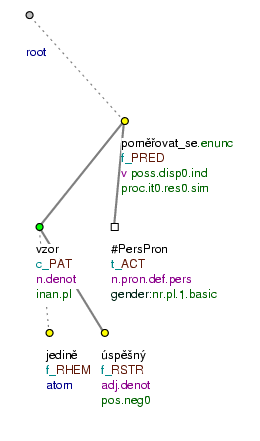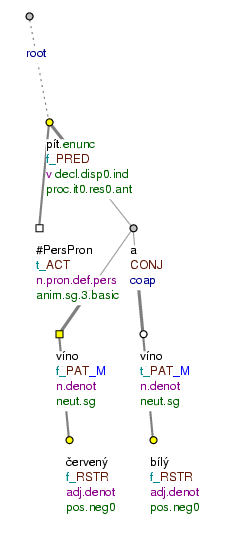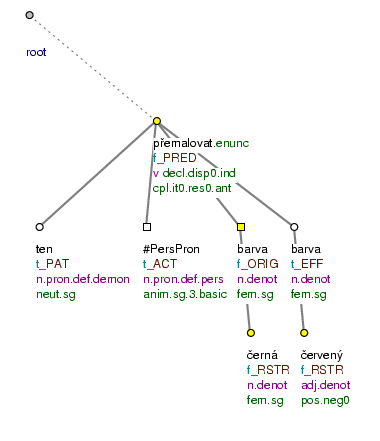According to their contextual boundness or non-boundness (see Section 2.1, "Context") we distinguish three types of expressions:
-
non-contrastive contextually bound expression (see Section 2.2.1, "Non-contrastive contextually bound expression (value
tin the attributetfa)"), -
contrastive contextually bound expression (see Section 2.2.2, "Contrastive contextually bound expression (value
cin attributetfa)"), -
contextually non-bound expression (see Section 2.2.3, "Contextually non-bound expression (value
fin attributetfa)").
Non-contrastive contextually bound expressions are expressions (both expressed and absent in the surface structure of the sentence) that introduce in the text some "given information". Such expressions are repeated from the preceding text (not necessarily verbatim), they are deducible from it (e.g. using coreferential or inferential relationships), or somehow related to a broader context.
A tendency towards contextual boundness is exhibited by expressions modifying the sentence as a whole (e.g. connecting and attitudinal particles) and local, temporal and circumstantial adjuncts, if they fulfill the role of so-called settings (setting the scene). Contextually bound are usually also nodes representing elements absent in the surface structure (for that see Section 2.2.4, "Contextual boundness of expressions absent in the surface structure of the sentence").
A key relationship for determining (the value of) the contextual boundness of an expression is coreference. When annotating topic-focus articulation, we take into account a wider domain of coreferential relationships than the ones annotated in the tectogrammatical trees (for the annotation of coreferential relationships see Chapter 9, Coreference).
Nodes representing non-contrastive contextually bound expressions are assigned the value t in the tfa attribute.
(A node with value t in the attribute tfa is also called a non-contrastive contextually bound node. )
Contrastive contextually bound expressions are contrastively bound expressions, which can be usually identified according to the following properties:
-
a contrastive contextually bound expression is usually a choice from a set of alternatives. This set need not be explicitly specified in the text. A contrastive contextually bound expression can refer to a larger text segment and does not have to be deducible from the immediately preceding textual context.
NB! Choice from a set of alternatives (contrast) is also typical of contextually non-bound expressions. Cf. examples:
-
(Dnes tu knihu ještě čtu.) Přinesu ti ji zítra [
tfa=f] (=lit. (Today the book.ACC still (I) am_reading.) (I) will_bring to_you it tomorrow.) -
(Dnes nesu jen dopis.) Tu knihu [
tfa=c] ti přinesu zítra [tfa=f] (=lit. (Today (I) am_bringing just (a) letter.) The book (I) to_you will_bring tomorrow)
-
-
the occurrence of a contrastive contextually bound expression is primarily determined by the thematic structure (progression) of the text. Contrastive contextually bound expressions usually occur in enumerations, at the beginning of paragraphs etc.
-
in the spoken form of an utterance the contrastive contextually bound expression carries an optional contrastive stress (see Section 1.2.2, "Contrastive stress").
Nodes representing contrastive contextually bound expressions are assigned the value c in the tfa attribute.
(A node with the value c in the attribute tfa is also called a contrastive contextually bound node. )
Examples:
Jedině [tfa=f] s úspěšnými [tfa=f] vzory [tfa=c] se můžeme poměřovat [tfa=f] (=lit. Only with successful models _ (we) can compare.) Fig. 10.1
Jemu [tfa=c] to [tfa=t] Martin [tfa=t] nedal [tfa=f] (=lit. To_him it.ACC Martin did_not_give.)
Janu [tfa=c] Marie [tfa=t] neviděla [tfa=f] (=lit. Jane.ACC Mary did_not_see.)
!!! The guidelines for assigning the value c are somewhat vague, the main reason being that it has not yet been well established where contrast can occur and what factors influence its presence.
Contextually non-bound expressions are expressions (both expressed and absent in the surface structure of the sentence) that represent in the text some unknown, new facts, or introduce known facts in new relations, i.e. they express information not deducible from context.
Contextually non-bound expressions can carry the intonation centre of the sentence (see Section 1.2.1, "Intonation centre").
Nodes representing contextually non-bound expressions are assigned the value f in the tfa attribute.
(A node with the value f in the attribute tfa is also called a contextually non-bound node. )
NB! Even expressions repeated verbatim from the preceding text can be contextually non-bound if they differ in modality, some grammatical category, etc. Such an expression brings new information, and is therefore considered to be contextually non-bound.
Example:
Ještě jsem to nenapsal [tfa=f]} , ale zítra to napíšu [tfa=f] (=lit. Yet (I) have it.ACC not_written, but tomorrow (I) it.ACC will_write.)
Attribute tfa is also filled for newly established nodes representing elements absent in the surface structure of the sentence (is_generated=1; for rules on establishing new nodes in the tectogrammatical tree see Section 12, "Ellipsis").
Absent in the surface structure of the sentence are mainly expressions that have been already mentioned in the text, or are signaled by the grammatical categories of other words (e.g. non-expressed subject), or constructions where some part of the underlying structure is not expressed at the surface level (e.g. general arguments).
Certain lexical units are absent in the surface structure of the sentence precisely because they are considered to be deducible from context. Newly established nodes (representing elements not expressed in the surface structure of the sentence) are therefore in most cases assigned the value t in the tfa attribute.
Exceptions: Newly established nodes can be assigned tfa values f or c in the case of ellipsis of the governing noun in cases of paratactic connection of sentence parts (see Section 12.1.2.1, "Textual ellipsis of the governing noun") and in the case of ellipsis of the governing noun in binary relations of the type "from-to". The first occurrence of a noun, absent in the surface structure of the sentence, can be contextually non-bound or contrastive contextually bound (depending on context), while its second occurrence, expressed in the surface structure, is contextually bound.
Examples:
Pil červené { víno [tfa=f]} a bílé víno [tfa=t] (=lit. (He) drank red wine and white wine.) Fig. 10.2
Přemaloval to z černé { barvy [tfa=f]} na červenou barvu [tfa=t] (=lit. (He) re-painted it from black colour to red colour.) Fig. 10.3
Možné jsou studené [tfa=f] { večeře [tfa=f]} i teplé [tfa=f] večeře [tfa=t] (=lit. Possible are cold dinners and hot dinners.)
A newly established node can be assigned the tfa value f or c also in the cases of noun ellipsis after a preposition.
Example:
Neexistuje argument <pro>. { #PersPron.PAT [tfa= f]} (=lit. There_is_no argument <for>.)
A newly established node can be assigned the value f (or c) also in the case of a copied node differing from the original node in the value of some grammateme. Cf.:
-
Nechtěli nebo nemohli odklad platby povolit. (=lit. (They) did_not_want or could_not postponement.ACC of_payment to_permit.)
= Odklad platby {nechtěli povolit [
deontmod=vol;tfa=f]} nebo nemohli povolit [deontmod=poss;tfa=f]In the tectogrammatical tree there will be established (copied) a new node representing the modal predicate nechtěli povolit (=lit. (they) did_not_want to_permit), which differs from the original node in the value of grammateme
deontmod, thus carries new information and can be assigned the valuef.
A newly established node can be assigned the tfa value f (or c) also if it is the node for syntactic negation represented as rhematizer (t_lemma=#Neg and functor=RHEM) or if it is the root node of a foreign-language expression list structure (t_lemma=#Forn).


